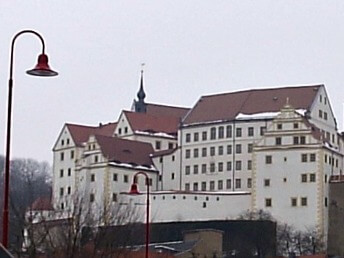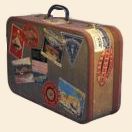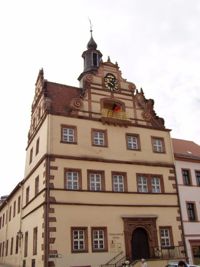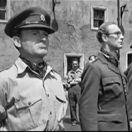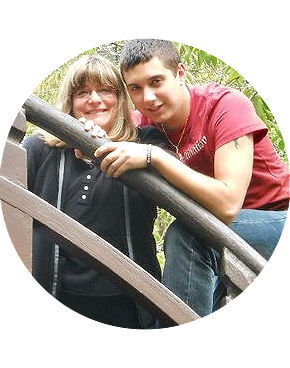Colditz Castle
The Famous WWII POW Camp
Starting in 1940, this gloomy, Saxon castle above a small town in eastern Germany was used to house the most "difficult" of the Allied POWs.
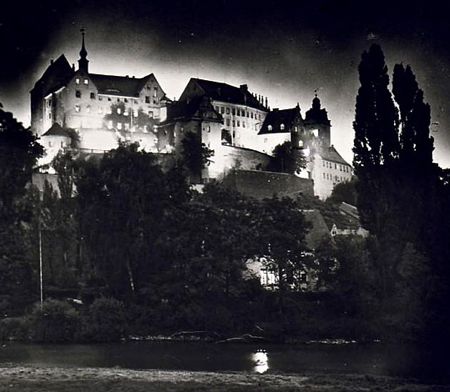 Colditz Castle 1943
Colditz Castle 1943The prisoners' dramatic and ingenious escapes have been the subject of over 40 books, two films, board games, video games and a popular TV series.
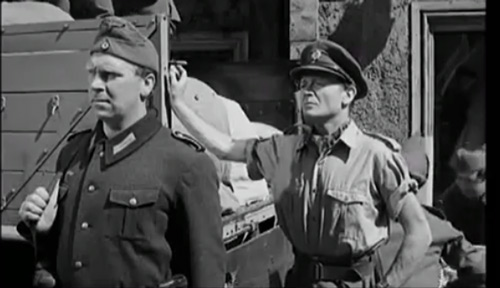 Scene from the Colditz Story, 1953
Scene from the Colditz Story, 1953Colditz History
International Collection of Bad Boys
Officers who had escaped from other POW camps or had otherwise given the Germans trouble were sent to this grim castle on the Mulde river.
This prison was unusual in having officers of different nationalities housed together in the same camp.
Polish officers were the first residents, followed by British, Canadian, Australian, New Zealanders, Dutch, Belgian, and French.
Later in the war, the prisoners were predominantly British. A handful of Americans were also imprisoned there at the very end. A few enlisted men were kept there who acted as orderlies, basically servants, for the higher ranking officers.
Captain Reinhold Eggers, the former German security officer, wrote in his book, Colditz, The German Story, "You might think at first sight that the place was impregnable. It probably was, but apart from putting bars on the windows it had never really been built for the purpose of keeping people in. Breaking out was shown to be much easier than breaking in!"
The Germans had their hands full. With a castle full of escape artists, it became an advanced escape school, with techniques becoming more and more sophisticated as the years went by.
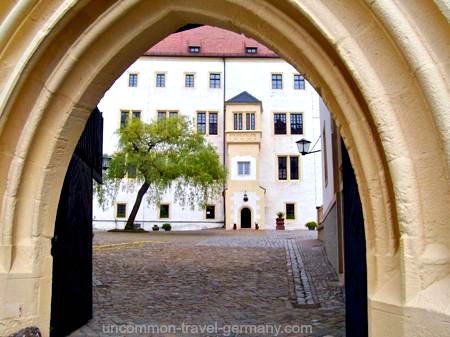 Entrance to the Prisoners' Courtyard
Entrance to the Prisoners' CourtyardA friendly rivalry developed among the different nationalities. The officers competed for the highest number of Home Runs, or successful escapes.
A bustling escape industry was occurring in the vast warren of rooms, passages and winding stairways that made up the prison.
Different departments were set up where men worked eight hours a day making fake ID's, civilian clothes, medals, false weapons and German uniforms.
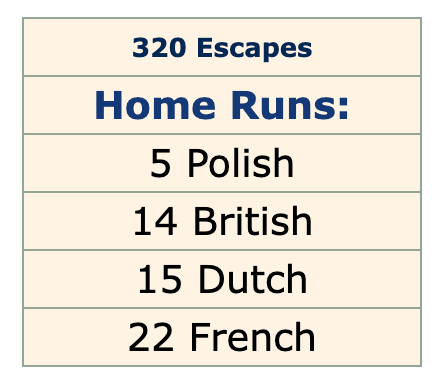
Stop That Lady!
A French officer almost got away dressed as a rather intimidating-looking woman. "She" made it past the sentries but then his luck ran out. As he walked past a group of prisoners out for their exercise, his watch slipped off his wrist. An unsuspecting prisoner picked it up and gallantly called out to alert her.
The French officer kept walking. The prisoner told the guard about the lost watch and the guard alerted the other sentry. When the second guard got a closer look at the "lady", the deception was discovered.
The Master Escape Artist: A Tragic Ending
Michael Sinclair, a red-headed British captain, was one of the experts. The Germans called him the Red Fox and distributed his picture throughout Germany. He escaped nine times, twice from Colditz.
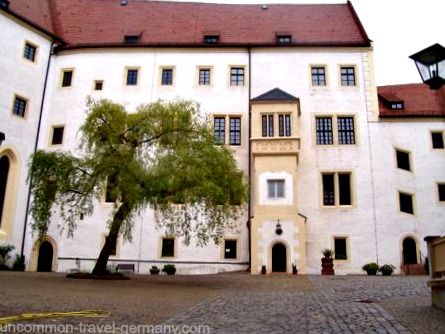 The Prisoners' Courtyard
The Prisoners' CourtyardOnce he disguised himself as one of the senior sergeants of the guard, a veteran of WWI with long, flowing white mustaches that the prisoners called "Franz Josef" after the former Emperor of Austria.
He made it past the first two sentries, but the last one demanded to see a pass and Sinclair was discovered; his was the wrong color. Sinclair was shot in the chest during the argument, but survived. The guard was sent to the Russian front.
Another time he made it as far as Bulgaria with the help of a Polish couple from Warsaw. Unfortunately, the Poles were also caught and sent to Auschwitz, where they died.
Sinclair himself was killed in an escape attempt when he jumped the fence, ran for the woods and was shot by one of the guards. He was the only prisoner killed while escaping from the castle.
The French Tunnel: What's All That Racket?
The French officers came very close to pulling off what would have been the most massive escape of the entire war. All 200 French prisoners were going to make a run for it when the tunnel was ready.
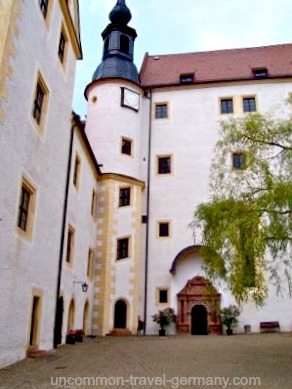 The Clock Tower
The Clock TowerA clock tower with a circular stairway went from the prisoners' courtyard to the attic three stories up. During a period of eight months, The French created a tunnel that went from the top of the clock tower all the way down to the wine cellar under the building and right through the medieval foundation of the castle -- 44 meters long.
It was an enormous project involving 31 men and tons of debris. The diggers were brazen; the castle echoed with banging and scraping noises all night, every night. Everyone, including the Germans, knew a huge tunnel was being constructed, but where was it?
The Germans were desperate. They conducted searches day and night, but no luck. The sounds could now be heard from all over the castle, inside and out, and still they couldn't find it. Their microphones weren't able to zero in on the location.
Captain Eggers was getting more and more worried; based on the material they kept finding, he knew that they had reached the castle foundation. Then dirt from outside the castle walls started appearing!
Almost There
The break-out was scheduled for January 17; they had only 12 feet to go. On January 15, an observant security officer was searching the attic of the clock tower. He looked behind the workings of the clock to the floor below and saw something that shouldn't have been there: a ladder. He found a small boy and lowered him down into the small space. "There are prisoners down there!", the frightened boy shouted. And the tunnel was found.
The tunnel is still there and can be seen on the castle tour. The French had even put in electric lights for the entire underground portion and had a cart running on a track.
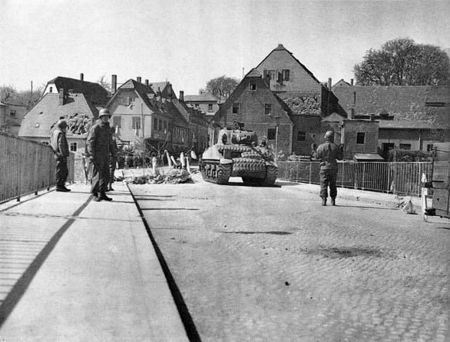 An American Tank Arrives in Colditz 1945
An American Tank Arrives in Colditz 1945Interested in hearing more Colditz stories?
Find out how some of the officers drove the guards crazy and what the men did for entertainment when they weren't escaping
Visiting Colditz
English language tours are available and visitors can see the prison yard, the prison chapel, theater, tunnel entrances and the rooms where the VIP prisoners were kept.
See the Colditz Castle webpage for dates, times and prices for the tours, plus which areas are currently available for visiting.
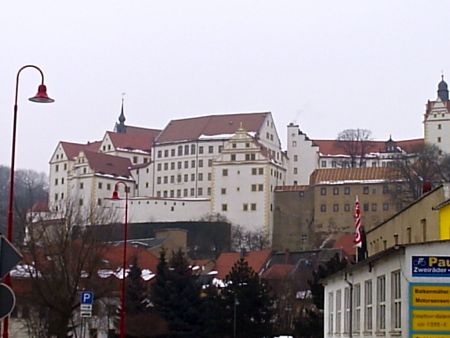 Colditz Castle in Winter
Colditz Castle in Winter(Photo courtesy of Pete Nowakiwskyj)
The castle has undergone extensive renovation in recent years, which has been somewhat controversial. Understandably, structures do need to be painted and maintained, but many Colditz history buffs are concerned that historic aspects of the castle from the WW2 period may be forever lost in the desire to modernize and use the castle for other purposes.
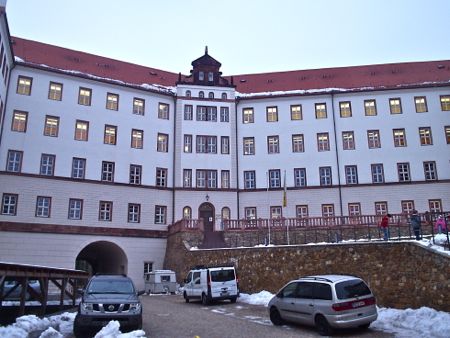 Youth Hostel and Music Academy (formerly the Colditz Garrison)
Youth Hostel and Music Academy (formerly the Colditz Garrison)(Photo courtesy of Pete Nowakiwskyj)
In April 2007, a youth hostel was installed in the section of the castle that housed the German garrison at Colditz, and a music academy was added in 2009.
The castle buildings have been painted off-white and look a lot prettier than they did during the war years, but climbing the steep walkway and walking through the stone passages still gives one some feeling of what it must have been like.
Visiting the castle is a fascinating experience. Being here and seeing the strength of this castle inspires enormous respect for the men who were locked up here and who used all their wits and courage to get out.
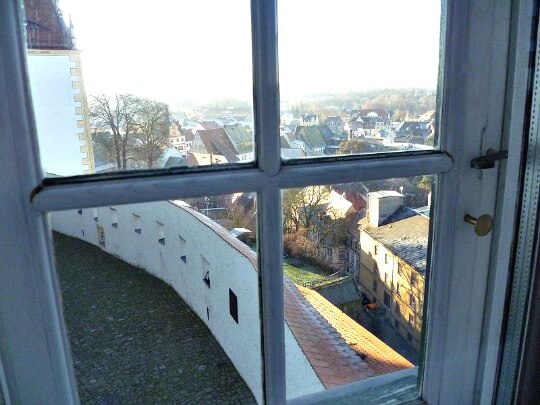 View of Colditz from the Castle
View of Colditz from the Castle(Photo courtesy of Ian Hall)
Escape Museum
An interesting collection of escape photographs and artifacts taken from the prisoners is on display in the castle museum (formerly the solitary confinement cells).
The Town of Colditz
The small town of Colditz is a charming collection of winding streets lined with half-timbered houses. Directly below the castle is a large market square (Markt) with a pleasant outdoor cafe where visitors can sit and admire the view.
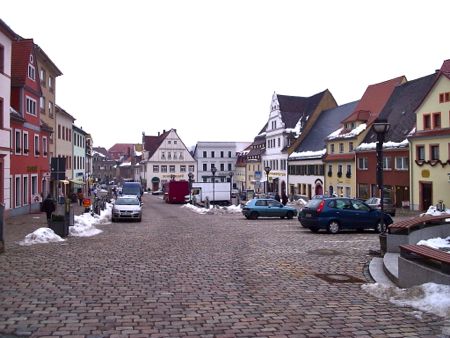 Colditz Main Square
Colditz Main Square(Photo courtesy of Pete Nowakiwskyj)
The Tourist Information Center is located on the street leading towards the castle just beyond the square. Check here for more info on Colditz attractions.
Excellent Colditz Video!
Mike Jones of the UK has created a great video with a virtual tour of the castle. See what the castle looks like now, along with lots of fascinating historical photos. Well done narration about the history, describing the escapes and pointing out the locations. (Be sure to watch Part 2 also.)
More Colditz Websites
A selection of other Colditz websites for more information about the castle and the town.
www.virtualcolditz.com
Photos and videos of Colditz correlated with escape routes.
www.pbs.org/wgbh/nova/naziprison/colditz.html
Cool interactive map with escapes pinpointed and linked to descriptions.
www.schloss-colditz.com
Official Colditz castle site. In German and English.
www.colditz.de
Official Colditz town site. In German.
Guided Tours
In addition to the tours given at the castle (see above), there is also a popular tour of Colditz Castle by Military History Tours.
Guests are met at the Berlin airport by the guide and given a three day tour of the castle and surrounding area, focusing on escape locations. See Escape to Colditz tour for more info.
More POW Camps
Stalag 13. The Stalag 13 of Hogan's Heroes was a real POW camp. See Stalag 13C for tips on visiting what remains of it, as well as the history of Stalag 13C.
There were actually four Stalag 13s's. Check out the experience of a Polish prisoner at Stalag 13B in Weiden, Germany.
To read a report compiled by the U.S. Military Intelligence Service about the conditions in POW camps holding American prisoners in Germany in 1944, see camp conditions report.
More on Colditz...
- Home ›
- Colditz Castle
Traveling in Germany
The last remaining Covid restrictions in Germany, in terms of vaccination and masking requirements, ended April 7, 2023.
See current Covid rules for more information.
Share this page:
